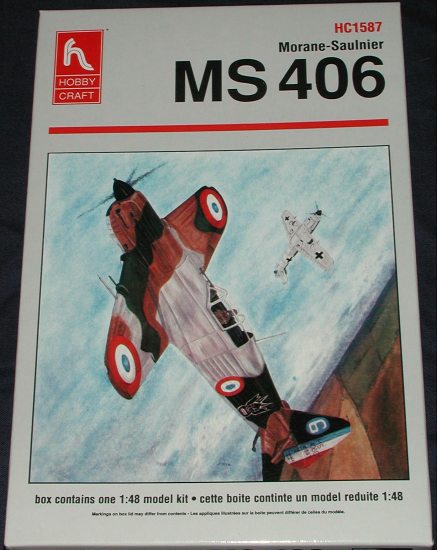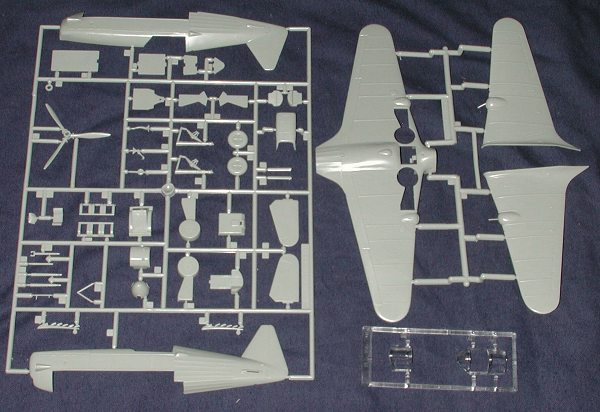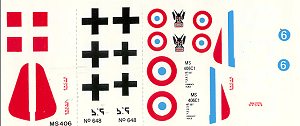
|
KIT: |
Hobbycraft 1/48 MS.406 |
|
KIT # |
1587 |
|
PRICE: |
$11.98 |
|
DECALS: |
Three aircraft |
|
REVIEWER: |
|
|
NOTES: |

|
HISTORY |
The MS.406 was the production version of the MS.405, a plane built to a 1934 specification for a modern monoplane fighter. The prototype 405 achieved a top speed of 298 mph and official trials ended in 1937. Meanwhile, a preproduction batch of 15 aircraft was ordered in 1936 with the first plane reaching the air force in early 1938. Various modifications were made on these MS.405s, including an uprated engine and redesigned wing. Preproduction MS.405 #13 was fitted with a non-retractable radiator and this version was license produced by the Swiss as the D.3800, 82 examples being built. An updated version, the D.3801 was also produced and was superior to the French versions, thanks to an engine of increased power.
The MS.406 incorporated many of the improvements made in various MS.405 airframes, but kept the semi-retractable radiator. 1,000 fighters were ordered in March of 1938 with production at one stage reaching eleven aircraft per day. All production was completed by March of 1940. At the start of WWII, the MS.406 was the most important fighter in French service.
It was also exported. Several were due to be sent to Lithuania, but were not delivered. Poland ordered 160, but the collapse of government prevented those from delivery. Sequestered during delivery were 13 aircraft sent to China. These were used by French Indochinese forces. Those that did make it were 45 supplied to Turkey and 30 sent to Finland. The Finnish 406s were further enhanced by 57 sent to them by Germany after the fall of France. Other captured aircraft were used by Croatia and by Germany.
In defense of France, the MS.406 did not fare very well as it was nearing obsolescence. Most of the French aces were flying the superior Curtiss Hawk 75. However, two of the pilots to reach that status were flying the MS.406. As is often the case, a talented pilot can make up for a less than optimal aircraft, and those flown with skill were able to bring down a goodly number of enemy planes.
|
THE KIT |

Hobbycraft has stood for a decent kit at a decent price and this one is no different. You won't find the level of detail that is found in some other products, but you also won't have to take out a loan to buy the kit. This one is no different.
Overall detailing is fairly good, though perhaps a touch heavy-handed in places. It comes with a relatively complete interior, though there is no sidewall detail. There are also no real options other than the separate canopy and the option to have shorter exhaust stacks (which must be cut for this option). The wheel wells have no real detail in them and are inserted from the outside of the wing after it has been constructed, an interesting way of doing things. As you know, I don't measure kits nor compare them against plans. I have heard that there are a few shape problems, but not being an enthusiast of the type, I don't know what they might be. I'm sure that a reader will be able to enlighten me.
 Instructions are still adequate
for the job, but the lack of any color information aside from exterior
camouflage is irritating to say the least. I'm going to assume that the usual
dark blue was used for the interior and the underside color for the gear wells
unless someone knows differently. Decals are for three planes, all in various
disruptive camouflage. There is a French version of CG III/6 during 1940, a
Turkish plane and one supplied to a German training unit. Exterior colors are
given as FS numbers only, which is a bit of a help, but having the proper
French/German designations would have been helpful as well. Decals are well
printed, and very glossy. I'm not sure if these are usable or not as some Hobby
craft decals are terrible. One thing I do know is that the blue is MUCH too
bright a shade. Fortunately, there are a number of aftermarket sheets for this
plane and one of those would probably be a good choice.
Instructions are still adequate
for the job, but the lack of any color information aside from exterior
camouflage is irritating to say the least. I'm going to assume that the usual
dark blue was used for the interior and the underside color for the gear wells
unless someone knows differently. Decals are for three planes, all in various
disruptive camouflage. There is a French version of CG III/6 during 1940, a
Turkish plane and one supplied to a German training unit. Exterior colors are
given as FS numbers only, which is a bit of a help, but having the proper
French/German designations would have been helpful as well. Decals are well
printed, and very glossy. I'm not sure if these are usable or not as some Hobby
craft decals are terrible. One thing I do know is that the blue is MUCH too
bright a shade. Fortunately, there are a number of aftermarket sheets for this
plane and one of those would probably be a good choice.
|
CONCLUSIONS |
It does not appear to be a difficult model to build, so I can recommend this one for just about anyone. It is also a kit I don't recall seeing built. There is a much more expensive Classic Airframes version around that is undoubtedly much more detailed than this one, what with all the resin bits included. However, for modelers on a budget or those who don't care about winning contests, this is the one to choose.
|
REFERENCES |
Fighters, Volume 1, William Green, 1960
If you would like your product reviewed fairly and quickly by a site that has well over 150,000 visitors a month, please contact me or see other details in the Note to Contributors.